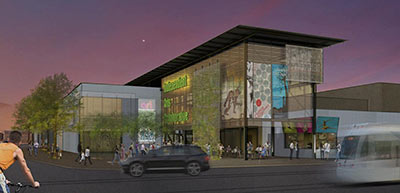
San Antonio’s Lake Flato Architects and Houston’s Studio Red have completed what they’re calling a schematic design for the new 59,000-sq.-ft. Midtown arts center planned for the full city block at 3400 Main St., adjacent to the Ensemble/HCC light-rail stop. And that means: Yes, presentations to the board of the Independent Arts Collaborative, but also the follow-on posting of the design on the organization’s Facebook page — to see what further reactions come in. The latest plans elaborate on the design team’s concept of separate spaces connected by an open-air central breezeway (the tall structure at right in the above image, viewed from the corner of Main and Holman), but make clear that the theaters are the project’s focus.
***
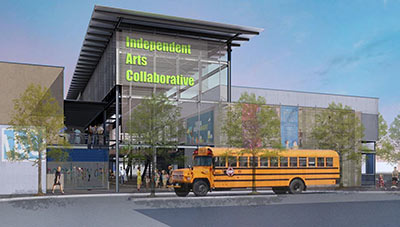

5 separate ground-floor gallery spaces are shown, but all except for the largest — a box-shaped space at the corner of Travis and Holman (at right in the view from Travis St. below) — are meant to double as theater lobbies.
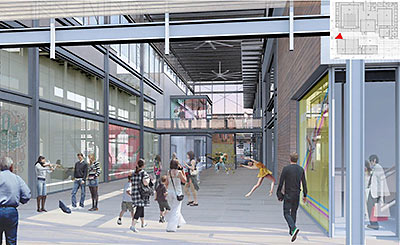
The breezeway, covered and wrapped in perforated metal panels, runs from Main to Travis St. Dehumidified air exiting the theaters would enter it and swirl around, stirred up by large overhead fans. Glass walls of the multi-use theater lobbies and the dedicated gallery face into the tall space, the glow of activity behind them acting as “welcoming lanterns” to visitors at night, according to the description accompanying this rendering:

The busiest corners of the building should be the ones at either end of Holman St.; facing Francis St. and the northern portions of both Main and Travis streets are blank walls sheathed with corrugated metal panels and peppered with expanses of translucent glass:
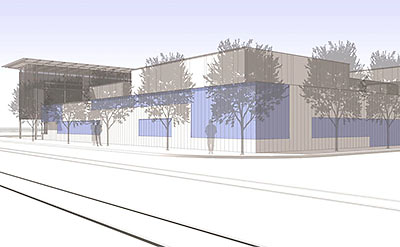
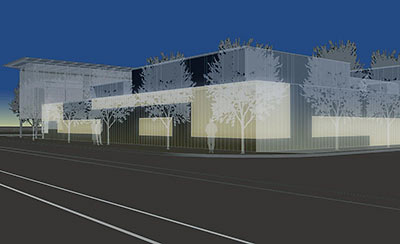
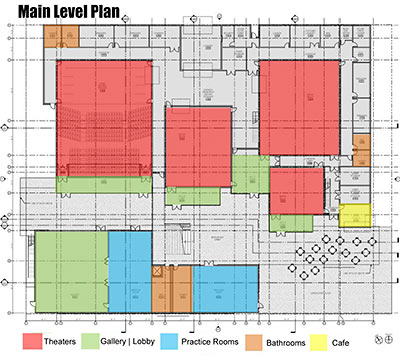
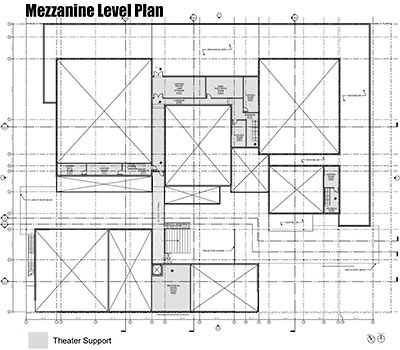
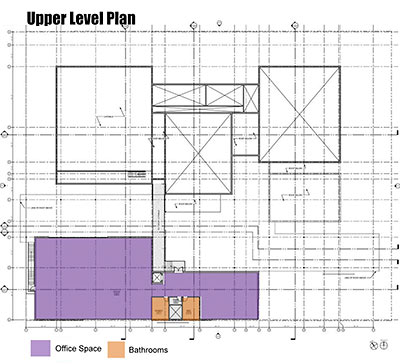
Also included: diagrams of the 4 tilt-up concrete theaters, only 1 of which would have fixed seating:
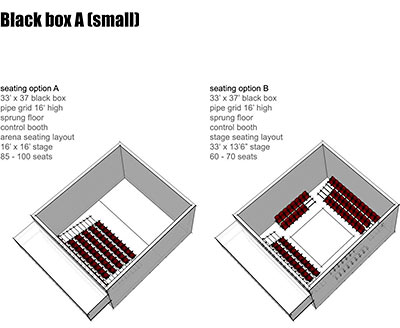
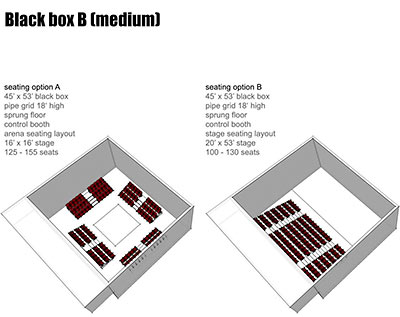
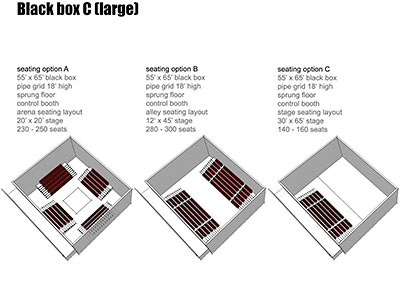
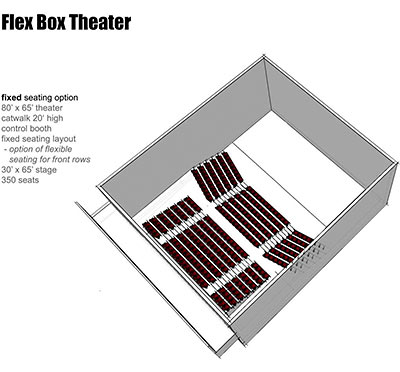
The complex is meant to share a parking garage with a retail development planned for up the street. “There is much to share and discuss,” announce the IAC’s design-discussion-group facilitators on Facebook. “Many elements are still in flux — elements presented here may not make it into the final design while other elements might be added. With that said, things are becoming solidified enough to have a conversation, so let’s have one.”
- IAC — Schematic Design [Facebook]
- Previously on Swamplot: The Midtown Collaborative Arts Yurt That Got Away, A Second Round of Initial Concepts for Midtown’s Independent Arts Collaborative, Architects Agree To Collaborate on Main St. Arts Collaborative, Independent Arts Collaborative Buying Midtown Lot for New Main St. Arts Center
Images: Lake Flato Architects, Studio Red Architects





Is it just me or does visual art get a short shrift here. There are two galleries, the larger of which is smaller than all but one of the four theaters. (And counting the lobby space for each theater as gallery space is bullshit.) I can’t really tell how big the gallery space is, but Diverse Works currently has a cavernous warehouse space–will these two galleries equal what they already have?
This will be a nice addition to Midtown…I wish we knew more about the commercial development with the parking garage that supposed to be shared with this facility.
nice HEB.
Not sure I like the “central breezeway” plan that seems to turn its back on the actual main streets this project will be situated on. Is this Houston Pavilions 2.0? Isn’t the whole point of art to engage the community? I think the folks over at Flato + Red are trying to hard.
Love, LOVE the breezeway concept. That MUST stay. It gives it a walkable European feel; just love it.
I just hope the walls facing the streets do not make it feel closed off. I hope they lean more towards the new ballet building than not, if possible.
wow, if i didn’t know any better . . . i’d think i was looking at a new HEB in the Heights. way to go LF . . . very original.
I think the HEB on Alabama and the Apple store in Highland Village just had a baby.
Dear Swamplot. Your photos need to be more than 400px wide. Welcome to 2012.
Looks like a design for a tight budget. Very warehouse like. Lots of boxes, low cost and low maintenance materials. Very understandable considering the level of fundraising that needs to happen in order to pay for this. Lake Flato seem to be making the best of the financial limitations. I wish they had more money to work with in order to do something that is really a landmark. While there has been some very generous donations to get this project moving, you have to wonder why a Kinder, Duncan or Mitchell couldn’t write a huge check and get their name on the door of something truly outstanding.
Old School, I think that “warehouse-like” design is not necessarily for economy but because it’s been a trendy style for the past 10-15 years, starting with the “tin shed” townhouses and has picked up steam with commercial bldgs recently. This reminds me of the Art Deco/Moderne style from the 30s-40s that also encompassed both residential and commercial. Houston will have lots of examples of this distinct style come 50 years or so from now when they become cool classics, if they can survive that long.
Where’s the coffee bar?
Can’t they just lease some eleventh-generation warehouse space somewhere in the East End? Why do they need new warehouses in an expensive neighborhood?
Ditto on what Schwaghag said but otherwise sweet!!!
So it’s a warehouse with that “replaced some parts at the junkyard” vibe of multiple colors?
The Niche: Presumably they want it in a neighborhood that has an already established art scene so that it can take advantage of the cluster effect. And don’t forget, a lot of Houstonians are afraid to go to the “ghetto”–even Midtown is a stretch for some. (I realize this seems insane, but a lot of people in the suburbs–where I live–feel this way.)
That said, you are right. The scenario you describe is exactly what Frenetic Theater did. They acquired a crappy old machine shop on Navigation in 2006 and have been gradually improving it. Now they have a theater, a practice room, A/C, a lobby, etc. But it’s still a work in progress. This is a model for non-profits that don’t have deep pockets.
This is an opportunity to do something unique in Midtown and we get this? Modest at best, and kind of predictable at worst. Isn’t this what one would imagine being proposed with the selection of firms? At least try to do something assertive and visually dynamic.
I was going to say it looked like a WHole Foods, but people beat me to it with the HEB comparisons.
For those complaining of the design and looks, for the current state of the economy in the U.S. (even if Houston is doing good), the level up support for generous support for the arts and venues at the non-corporate larger donor level is low. The fact that this is getting pulled off right now is a big deal.
For the area of MidTown this will occupy, it does seem fairly unique and would be a grate addition to the area. The area along the Elgin Corridor in Midtown is getting a lot of diversity in land uses and a good mix of development. Knocking this on architectural merits dismisses the bigger picture this facility (and the supposed adjacent parking garage and commercial development are going to add to the area.
@ Robert Boyd: The East End’s art scene is thoroughly established; it has more in its little pinky finger than Midtown has altogether.
the Niche: I was thinking more of art/performance destinations–museums, galleries, performance spaces. Main Street has a lot, many within walking distance of one another. In the East End, there is Talento de Bilengue, Frenetic Theater, Box 13, El Rincon Social, Super Happy Fun Land, Barnevelder Movement/Arts Complex, Kalinen Contemporary, and probably some things that I’m missing. That’s a pretty good set of arts spaces, but it’s very spread out (from near 59 all the way out to Broadway). What is definitely going on in the East End is that a lot of artists have living and/or work spaces there (even though they have exhibits, both El Rincon Social and Box 13 are primarily studio spaces). But that’s not the same as being a destination for people to see art/performances.
Whereas the Midtown/Museum District arts area is much more compact–only 1.5 miles from the Midtown Arts Center to the MFAH–and in between you have the Continental Club, Inman Gallery, Bryan Miller Gallery, Art Palace, Devin Borden Gallery, War’House, the Houston Center For Contemporary Craft, Lawndale, the Ensemble Theatre, the MFAH–and that’s just on Main St.
But again, I partly agree with you. If I was a scrappy young arts group looking for a physical home, I’d look out in the East End before Midtown. You just aren’t going to get things like Super Happy Fun Land, Frenetic Theater or Box 13 in Midtown.
To be clear, this is a great idea and a great location. This development is going to piggyback with a new retail development next door and make a huge impact on midtown. It is also a brilliant idea to pull together smaller performing and visual arts organizations under one roof. Just having a centralized website for ticket sales will create beneficial synergies. It will also be a huge benefit to performing arts organizations to not be at the whim of a landlord who might put the organization out of business or out of a home by raising the rent.
While individual contributions to arts organizations across the US have been devastatingly low (Philadelphia Orchestra declared bankruptcy and the NY Opera is looking at operating with a part time orchestra for the first time ever), Houston arts organizations have weathered the economic storm quite well. And there are plenty of big money people in Houston that could step up and really make this a major arts center for Houston. Dan Duncan built a wing to the Natural History Museum. Why can’t Jamail, Kinder or some of the other big bucks guys in Houston write a big check to get their name on this place so that it wouldn’t have to be such a cost effective and minimal design?
“Why can’t Jamail, Kinder or some of the other big bucks guys in Houston write a big check to get their name on this place so that it wouldn’t have to be such a cost effective and minimal design?”
Maybe they are tapped out having given money for the new MFAH building, the Menil drawing center or the new Rice art department building… Lots of big orgs with their hands out.
Old School doesn’t understand that the people with a lot of money give plenty even if something you support doesn’t get any. I have some friends that work for the Zoo in their fundraising team. The Zoo is completely private now (which is why it’s has gone up in quality so much) and must fend for itself. Ticket sales, although up, don’t pay for much at all. The money to keep that zoo going is from large donors. They also started the monthly Flock event where they hold parties in the zoo and allow donors to get up close to the animals. These events are much cheaper for smaller donors and allow young professionals to play roll in supporting the zoo. The Zoo is a success story.
All of these arts groups have events throughout the year to keep fundraising. If you ever look at PaperCity and see all the big money types that always seem to be partying, you need to realize that they are pay a lot party and that money is funding the arts and many other charities.
it would be nice if there wasn’t boring sheet metal showing to the street on nearly all sides, but it is still an improvement, so I won’t complain.
@ Robert Boyd: Again, if they have to cater to a more “delicate” crowd, then I get why they need to be within civilization…but even then, I just don’t get Midtown. The Museum District would be the superior choice.
TheNiche: Could it have been availability/price of the land? Perhaps this was the closest space they could get to the Museum district that they could get for their budget and within the time frame they needed to buy it.
In any case, their current location puts them 1 block from the Ensemble theater, 3 blocks from the Continental Club (and Natachees and T’Afia and Julia’s), and 5 blocks from the Isabella Court galleries. So it seems like it’s in pretty good company to me.
The location is the old City of Houston services building. The City did a deal to sell it to the arts organization to build the center pursuant to a 380 agreement. The new arts building will be deeded back to the city when complete and maintained by the organization. The organization has to raise the funds to build it (@$22 mil). Plus, another developer is doing a development next door that will share parking and feed off the traffic from the arts center. It was a perfect convergence of the City wanting to offload some land and a private developer interested in building something in tandem with the arts center. Nowhere else in the City would that have been able to happen in the same way.
I stand by my finger wagging at the ultra rich of Houston. Houston’s big money men of the past left their mark on this city’s arts scene (Cullen, Jones, Wortham, Beck, De Menil, etc.) with major art museums and performing arts halls. Here comes the next big arts venue in Houston and no one, to date, has shown up to write the big check. That is shameful in a city that has made many men rich beyond their wildest dreams. Sure, they have all set up big foundations and given plenty of money. But, this is a once in a lifetime development that should have the City’s big money guys fighting it out like Carnegie and Rockefeller did back in the day to see who was the biggest philanthrapist. Heck, Dan Duncan’s kids are sitting on @3 bil each just for having the right genetics. They could just take some of the annual returns on their inheritence and pay for this center outright.
It’s a pretty good block. Very easy access to both 59 and 288, and an immediately adjacent light rail station as well. There are also several new mixed use developments that are supposedly coming in nearby (Crosspointe) and a couple other nearby blocks that could also be redeveloped to much better uses. The block across from Isabella Court might be slightly better, but that’s only a few blocks south.
Any block in the Museum District probably would have been much more expensive…
Old School,
How do you know none of the really rich gave any money?
Many of those venues don’t get names right away and often get the name after the person is dead. There are some exceptions.
Maybe a group is giving money and they don’t want to give one of them credit over the other. There are lot of unknown for there to be a rant over rich stiffing this place.
Also, I guess the 380 agreements are OK for this facility and new commercial development but not for Walmart? I know that was a rub for many posters on here about the public/private deal.
Old School: Is John D. Arnold’s name on anything yet?
Oh, I see. The City threw money at them haphazardly. That explains everything.
TheNiche, the city didn’t throw any money at them. Where did you get that idea?
Kjb, because otherwise it would be called the (insert last name here) Center for the Arts.
Mel, the city’s part is the arrangement of the 380 agreement and the selling of the land (at a very reasonable price). The city didn’t spend money.
Also, the city having any role in this doesn’t preclude a name getting attached. The construction costs are all from donations. I see this place getting a name on it by the time it opens….
380 Agreement
It’s recycling the Pearl Brewery in San Antonio. Only this is wayyy inferior. I expected more from Lake/Flato. They are really missing a great opportunity. I hope they can re-evaluate their design.
While the budget may have been a concern, I don’t think it drove the design. This is what Lake Flato buildings look like.
HEB-like or not, the success of this project will be measured on the basis of whether it can serve as a catalyst for creating a neighborhood that people actually want to visit. So lets see what sort of commercial development follows along.
kjb434, I didn’t say anything about whether the city spent money on this project. What I said is that we can be fairly certain no big private donor is attached to this project, otherwise the building would be called “The [insert rich person’s name here] Center for the Arts.”
I don’t get why LF is so highly regarded. We have tons of local talent that can and should be the lead designer on this project. EVERYTHING the hill country chic archs ever do looks just like something else they already did.
John Arnold has set up a foundation that is dedicated to pursuing his ideological goals in criminal justice reform, pension reform and school reform. He has given generously to HISD initiatives. As far as I know, he has never put his name on a building. His philanthropy does represent a common shift in modern philanthropy away from what the robber barons were fond of (public parks, museums, performing arts centers) to public interest advocacy. The public interest advocacy philanthropy has run the gamut of the Gates foundation’s focus on vaccine and third world development to the very partisan political work of Soros and Koch (left and right, respectively). It is a shame that bankrolling the arts and public spaces (parks, botantical gardens) has generally fallen out of vogue with philanthropists, although the Walton family just completed a $1.2 billion art museum in Bentonville Ark. The Heinz family foundation funded the Pittsburgh Symphony for several decades. The endowment was so generous that the orchestra had to do very little fundraising and ran on the endowment and ticket sales. Likewise the Cleveland Orchestra has a legacy of big steel money that has enabled the orchestra to be one of the top five in the US in a city that has seen a steady decline in population and economic conditions over the past twenty years.
It’s all well and good to have a foundation, but what’s the fun of being a billionaire if you don’t have some buildings with your name on it?